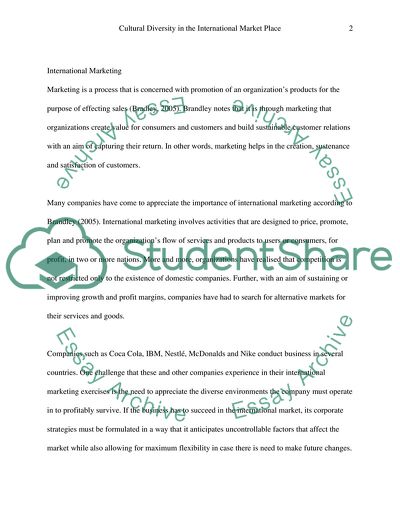Cite this document
(Cultural Diversity In The International Market Place Case Study, n.d.)
Cultural Diversity In The International Market Place Case Study. Retrieved from https://studentshare.org/marketing/1730591-culture-is-one-of-the-most-challenging-elements-of-the-international-marketplace-two-schools-of-thought-exist-in-the-business-world-on-how-to-deal-with-cultural-diversity-one-is-that-business-is-business-the-world-around-the-other-school-pr
Cultural Diversity In The International Market Place Case Study. Retrieved from https://studentshare.org/marketing/1730591-culture-is-one-of-the-most-challenging-elements-of-the-international-marketplace-two-schools-of-thought-exist-in-the-business-world-on-how-to-deal-with-cultural-diversity-one-is-that-business-is-business-the-world-around-the-other-school-pr
(Cultural Diversity In The International Market Place Case Study)
Cultural Diversity In The International Market Place Case Study. https://studentshare.org/marketing/1730591-culture-is-one-of-the-most-challenging-elements-of-the-international-marketplace-two-schools-of-thought-exist-in-the-business-world-on-how-to-deal-with-cultural-diversity-one-is-that-business-is-business-the-world-around-the-other-school-pr.
Cultural Diversity In The International Market Place Case Study. https://studentshare.org/marketing/1730591-culture-is-one-of-the-most-challenging-elements-of-the-international-marketplace-two-schools-of-thought-exist-in-the-business-world-on-how-to-deal-with-cultural-diversity-one-is-that-business-is-business-the-world-around-the-other-school-pr.
“Cultural Diversity In The International Market Place Case Study”, n.d. https://studentshare.org/marketing/1730591-culture-is-one-of-the-most-challenging-elements-of-the-international-marketplace-two-schools-of-thought-exist-in-the-business-world-on-how-to-deal-with-cultural-diversity-one-is-that-business-is-business-the-world-around-the-other-school-pr.


